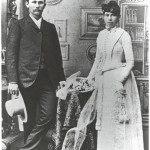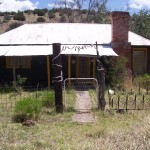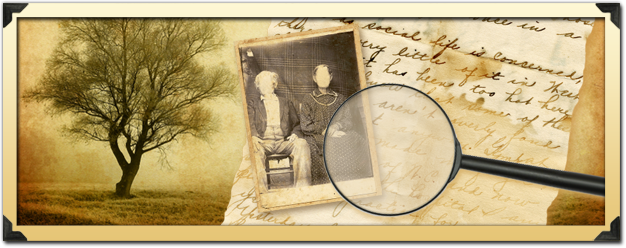John Joseph Filleman (1861-1942) married Annie Chisholm (1864-1931) in Uvalde, Texas in 1889. Soon after their marriage, they removed to eastern Arizona. They eventually purchased a cattle ranch in Graham County, along Eagle Creek, with the Four Bar brand. They raised nine children on Eagle Creek. The closest town, Clifton, was about fifty miles away on unpaved road, and took about 2 1/2 to 3 hours . Their children attended school in a one-room schoolhouse, and learned the ways of ranching life.
. Their children attended school in a one-room schoolhouse, and learned the ways of ranching life.
The border of the San Carlos Apache Indian Reservation ran very close to their property, and John became friends with the Apache chief. It was not unusual to see the Indian chief sitting on the Filleman’s front porch, visiting or exchanging gifts with them. One day, Annie rescued a young Indian girl being taunted by some reckless cowboys. That act further strengthened the bond of friendship. Not everyone cared to put forth the effort to build a friendship with the Apaches.
Annie brought a rose bush from Texas and planted it in their front yard at Eagle Creek. The blooms were cotton candy pink, and very large with thickly bundled petals. The variety was known as Fantin-Lamour, a type of cabbage rose, with a strong fragrance. Cuttings of this original Eagle Creek rose bush can be found growing in several of Annie’s descendant’s yards.
John brought fruit trees in to Eagle Creek and established a fine orchard of apple, peach, pear, cherry, almond and apricot trees. The apples he grew were so large that it only took one to make a whole pie. Life was good on Eagle Creek at the Four Bar Ranch, even through the depression years.
 Their cattle ranged free over many square miles of open land. Each spring, the men would go on round-up, to gather them in. The new calves were branded, and a certain number of older cattle were trucked in to Clifton to sell. Once when the men were away for several days on round-up, they hung a pot of pinto beans up in a tree in their camp. This would keep the critters from getting in to their beans while they were gone. But someone did not put the lid on quite tight enough. That night, after they heated up the beans over the campfire, they all agreed that the beans tasted especially delicious. As they reached the bottom of the pot, they found a large lizard skeleton!
Their cattle ranged free over many square miles of open land. Each spring, the men would go on round-up, to gather them in. The new calves were branded, and a certain number of older cattle were trucked in to Clifton to sell. Once when the men were away for several days on round-up, they hung a pot of pinto beans up in a tree in their camp. This would keep the critters from getting in to their beans while they were gone. But someone did not put the lid on quite tight enough. That night, after they heated up the beans over the campfire, they all agreed that the beans tasted especially delicious. As they reached the bottom of the pot, they found a large lizard skeleton!
Those were the golden days of the family-owned cattle business, a placid and prosperous way of life that is now gone forever.
What did your ancestors do for a living? What was daily life like for them? Let us help you discover those answers.
Raquel Lindaas, Accredited Genealogist®
Heritage Consulting





